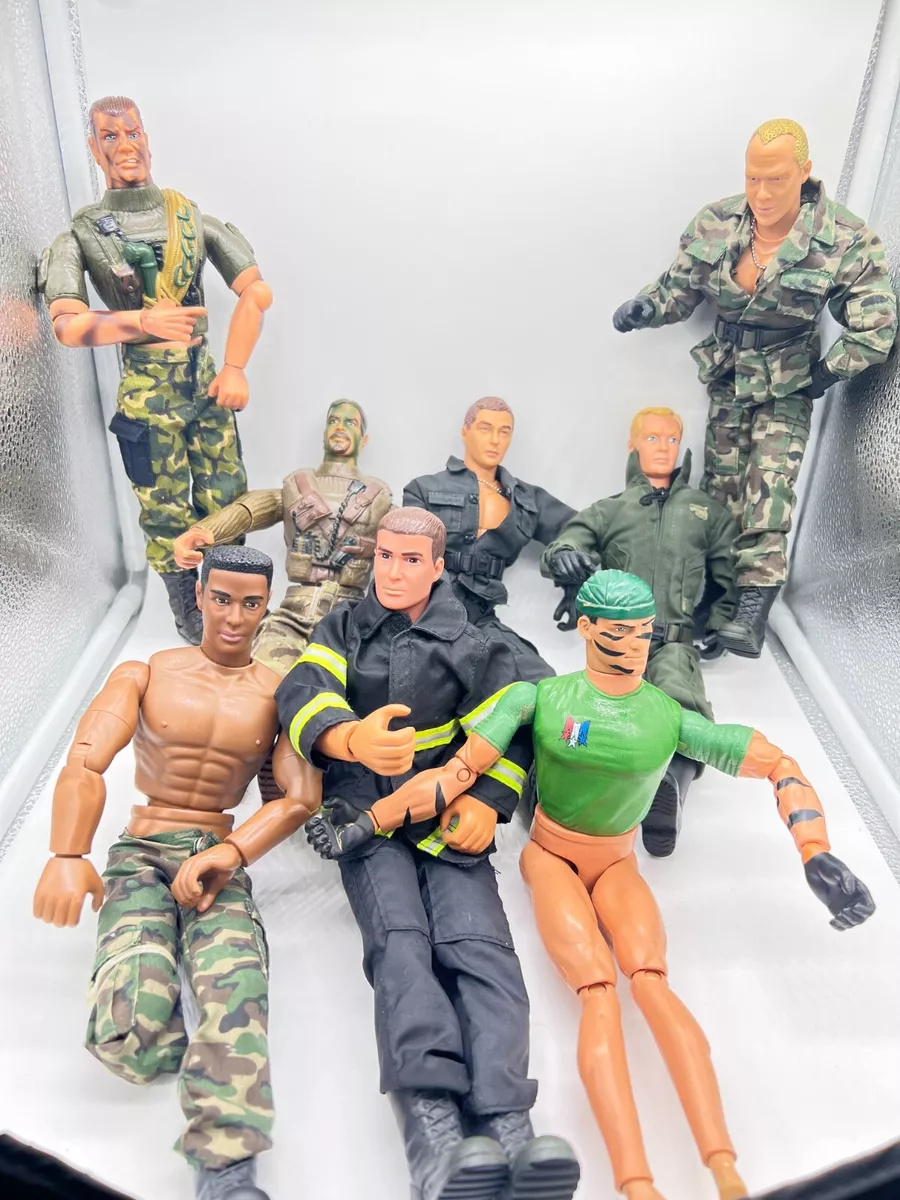G.I. Joe action figures, a cultural icon born in the 1960s, have etched their place in the hearts of collectors, enthusiasts, and generations of children worldwide. These miniature military heroes, with their meticulously crafted designs and richly woven narratives, have transcended mere toys to become symbols of adventure, camaraderie, and heroism. This comprehensive article delves into the captivating world of G.I. Joe, exploring its origins, evolution, and enduring influence on popular culture.

The Birth of an American Icon: G.I. Joe’s Genesis
In 1964, Hasbro, the renowned toy manufacturer, sought to create a toy that would capture the spirit of patriotism and bravery prevalent during the height of the Cold War. They envisioned a line of poseable action figures, each representing a member of the United States Armed Forces. Thus, G.I. Joe was born, named after the generic term for American soldiers—Government Issue (G.I.) Joe. The initial 12-inch figures, with their lifelike features, interchangeable outfits. And authentic military gear, quickly became a sensation among young boys who could now engage in imaginative play as valiant soldiers, sailors, pilots, or marines.
From Toy Soldiers to Pop Culture Phenomenon
As the Vietnam War era dawned, public sentiment towards military-themed toys began to shift. Hasbro responded by rebranding G.I. Joe as an “Adventure Team,” shifting focus from combat to exploration and rescue missions. This strategic move preserved the essence of the brand while adapting to the changing times. The Adventure Team era introduced new features like “Kung-Fu Grip” and “Life-Like Hair,” further enhancing the play experience and solidifying G.I. Joe’s status as a pop culture phenomenon.
The Advent of A Real American Hero: The 1980s Reboot
In 1982, Hasbro revitalized the G.I. Joe franchise with a groundbreaking redesign. Shrinking the figures down to a more compact 3.75 inches, they launched the “A Real American Hero” (RAH) series. This reboot not only featured an extensive roster of diverse characters but also introduced a richly developed storyline set against the backdrop of an ongoing battle between the heroic G.I. Joe team and the sinister terrorist organization Cobra. Accompanied by a popular animated TV series, comic books, and a prolific toy line, the RAH era catapulted G.I. Joe into the stratosphere of ’80s nostalgia, becoming synonymous with the decade’s vibrant toy culture.
Collectibles and the Nostalgia Factor
Decades after their initial release, G.I. Joe action figures continue to captivate collectors both young and old. Vintage pieces from the 1960s and ’70s, particularly rare or well-preserved specimens, command high prices in the collector’s market due to their historical significance and nostalgic appeal. The RAH series, with its vast array of characters, vehicles, and playsets, has also spawned a dedicated collecting community, driven by the hunt for elusive variants, exclusive releases, and the desire to recreate epic battle scenes from their childhood memories.
The Evolution of G.I. Joe in the Modern Era
The evolution of G.I. Joe, the iconic American action figure and toy line, has seen significant changes and adaptations in the modern era to keep pace with shifting cultural norms, advances in technology, and evolving entertainment trends. From its humble beginnings as a military-themed toy in the 1960s to its current status as a multimedia franchise, G.I. Joe has continuously transformed to resonate with contemporary audiences while maintaining its core values of heroism, teamwork, and adventure. Here’s a closer look at how G.I. Joe has evolved in the modern era.
Shift from Military to Action Adventure
In response to growing concerns about violence in children’s toys and media in the late 1980s and early 1990s, G.I. Joe underwent a significant shift from its original military-centric focus to a more action-adventure-oriented theme. This transition saw the introduction of science fiction elements, futuristic weapons, and an increased emphasis on the battle against Cobra, a technologically advanced terrorist organization, rather than traditional military conflicts. The “Real American Hero” tagline was dropped, and the brand adopted the new slogan “A Real American Hero: The Adventure Team,” reflecting this change in direction.
Diversity and Inclusion
Recognizing the importance of representation and diversity, modern iterations of G.I. Joe have actively sought to introduce characters from various ethnic backgrounds, genders, and nationalities. This effort not only reflects the changing demographics of society but also promotes inclusivity and positive role models for children. Characters like Shana “Scarlett” O’Hara, Kim “Jinx” Arashikage, and Roadblock (Eddie W. Drummond) were among the early examples of diverse representation in the franchise. More recent releases have continued this trend, introducing new characters like Dawn Moreno (a Latina taking on the mantle of Snake Eyes) and even expanding the concept of G.I. Joe to include international teams, such as the G.I. Joe Extreme series’ Tiger Force and Python Patrol.
Integration with Multimedia Platforms
To remain relevant in the digital age, G.I. Joe has embraced various multimedia platforms to engage fans and expand its narrative universe. Animated television series, direct-to-video movies, comic books, video games, and web content have all played crucial roles in modernizing the franchise. Notable examples include the highly successful 1980s animated series “G.I. Joe: A Real American Hero,” which introduced the iconic character Duke and popularized the catchphrase “Yo, Joe!” More recently, IDW Publishing’s ongoing comic book series has explored deeper storylines and character development, while streaming services have revived interest in the franchise with projects like the animated series “G.I. Joe: Resolute” (2009) and the live-action film “Snake Eyes” (2021).
Advanced Toy Technology
As toy manufacturing techniques have advanced, G.I. Joe figures have become increasingly detailed, poseable, and feature-rich. Modern figures often boast multiple points of articulation, intricate uniform designs, and accessories that incorporate LED lights, sound effects, and other interactive elements. Collectors’ editions and exclusive releases cater to adult fans seeking high-quality, screen-accurate representations of their favorite characters. Additionally, the integration of augmented reality (AR) apps has allowed for enhanced play experiences. And enabling users to interact with virtual content through their smartphones or tablets.
In the spirit of contemporary pop culture’s fascination with shared universes and crossover events, G.I. Joe has occasionally intersected with other popular franchises. Examples include the 2007 comic book miniseries “G.I. Joe vs. Transformers,” which pitted the Joes against their Hasbro counterparts, the Transformers, and the 201½ animated movie “Batman: The Brave and the Bold – The Battle of the Superheroes!”, which featured a brief cameo by G.I. Joe characters. These crossovers not only appeal to fans of both properties, but also demonstrate the adaptability and enduring popularity of the G.I. Joe brand.
Licensing and Merchandising Expansion
G.I. Joe has expanded beyond traditional action figures and playsets to encompass a wide range of licensed merchandise, including clothing, accessories, home decor, and collectibles. This strategy helps maintain brand visibility and attract new fans across different age groups and interests. Collaborations with fashion brands, limited-edition product drops, and convention-exclusive items cater to the growing market of adult collectors, while themed board games, role-playing games, and mobile apps offer interactive experiences for younger audiences.
G.I. Joe: An Enduring Legacy of Heroism and Imagination
From its humble beginnings as a line of patriotic toy soldiers to its current status as a multifaceted entertainment franchise, G.I. Joe stands as a testament to the power of imagination, storytelling, and the timeless appeal of heroism. Across generations, these action figures have ignited the spirit of adventure in countless children, fostering creativity, camaraderie, and an appreciation for the values embodied by their miniature military heroes. As G.I. Joe continues to evolve and adapt to the changing times, one thing remains certain: the enduring legacy of America’s movable fighting man will forever hold a cherished place in the annals of toy history and the hearts of fans worldwide.






